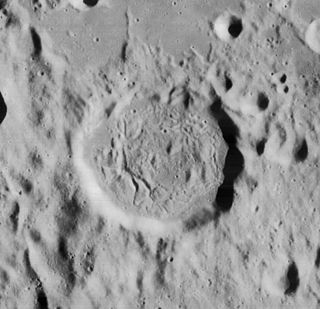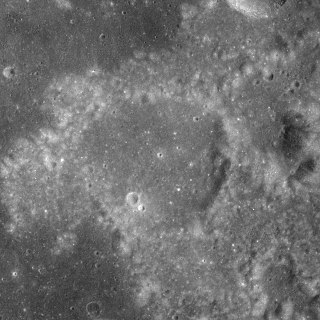
Dembowski is a lunar impact crater located to the southeast of the Sinus Medii. Its diameter is 26 km. It was named after Italian astronomer Ercole Dembowski. To the east are the craters Agrippa and Godin, to the southwest is Rhaeticus.

Abul Wafa is an impact crater located near the lunar equator on the far side of the Moon, named after the Persian mathematician and astronomer Abu al-Wafa' Buzjani. To the east are the crater pair Ctesibius and Heron. In the northeast lies the larger crater King, and to the southwest is Vesalius.

Bombelli is a small lunar impact crater that is located in the highlands to the north of the Sinus Successus. It was named after Italian mathematician Raphael Bombelli. It was previously designated Apollonius T. The crater Apollonius is located to the east-southeast.

Bode is a small crater located near the central region of the Moon, to the northwest of the joined craters Pallas and Murchison. It lies on a region of raised surface between the Mare Vaporum to the northeast, Sinus Aestuum to the west, and Sinus Medii to the southeast. The crater was named after German astronomer Johann Elert Bode.

Chladni is a small lunar impact crater that lies near the northwest edge of Sinus Medii, in the central part of the Moon. The crater is named for German physicist and musician Ernst Chladni who, in 1794, wrote the first book on meteorites. The rim of the crater is roughly circular, and there is a small central floor at the midpoint of the sloping inner walls. This feature has a higher albedo than the surrounding terrain. It is connected by a low ridge to the rim of the crater Murchison, which lies to the northwest. Due east of Chladni is the larger Triesnecker.

Sharp is a lunar impact crater located to the west of the Sinus Iridum bay of the Mare Imbrium, beyond the Montes Jura range. To the southwest is the crater Mairan. Because of its location and foreshortening, Sharp appears elliptical from the earth.

Flammarion is a lunar impact crater on the south edge of Sinus Medii. Its diameter is 76 km. It is named after the French astronomer Camille Flammarion. It is located between the crater Mösting to the northwest and Herschel to the southeast. The bowl-shaped Mösting A intersects the western rim of Flammarion.

Herschel is a lunar impact crater located just to the north of the walled plain Ptolemaeus. Its diameter is 39 km. It was named after German-born British astronomer William Herschel.

Bianchini is a lunar impact crater that lies along the northern Jura Mountains that ring the Sinus Iridum, in the northwestern part of the near side of the Moon. It was named after Italian astronomer Francesco Bianchini. The impact of this crater near the edge of the Jura Mountains deposited some material into the Sinus Iridum floor.

La Condamine is a small lunar impact crater that is located on the southern edge of the Mare Frigoris, in the northern part of the Moon. It lies to the northeast of the mountain-rimmed Sinus Iridum formation in the northwest part of the Mare Imbrium.

Helicon is a small lunar impact crater that is located on the north part of the Mare Imbrium. The crater was named after 4th century BC Greek astronomer Helicon of Cyzicus, a friend and disciple of Plato. To the northwest is the prominent Sinus Iridum, a mountain-ringed bay on the mare. Just to the east is the slightly smaller crater Le Verrier.

Benedict is a small, bowl-shaped crater that lies on the floor of the walled basin Mendeleev. It is located near the lunar equator on the far side of the Moon from the Earth.

Lyell is a lunar impact crater that lies along the eastern edge of the Mare Tranquillitatis, at the northern arm of the bay designated Sinus Concordiae. It was named after Scottish geologist Charles Lyell. To the north along the edge of the lunar mare is the crater Franz. The region of terrain to the east of Lyell is named Palus Somni.

Conon is a small but prominent lunar impact crater that lies in the eastern foothills of the Montes Apenninus mountain range. The crater is named for the Greek astronomer Conon of Samos. Just to the west of Conon is the long mountainous ridge Mons Bradley. The nearest craters possessing an eponym are Galen, about 70 kilometres (43 mi) to the east, and Aratus, about the same distance to the northeast.

Carmichael is a lunar impact crater that is located along the eastern edge of the Sinus Amoris, in the northeastern quadrant of the Moon's near side. Its diameter is 20 km. It was named after American psychologist Leonard Carmichael. It lies within a couple of crater diameters south-southwest of the smaller crater Hill. Further to the east-northeast is the prominent crater Macrobius. Carmichael was designated Macrobius A before being given its current name by the IAU.

Hill is a small lunar impact crater that is located to the west of the prominent crater Macrobius, near the eastern edge of the Sinus Amoris. Its diameter is 16 km. It was named after American astronomer George William Hill. It was previously designated Macrobius B. It lies just to the north-northeast of Carmichael, another renamed satellite crater of Macrobius.

Carnot is a large crater in the northern part of the Moon's far side. It intrudes into the southern rim of the huge walled plain Birkhoff. To the west-southwest of Carnot is the crater Paraskevopoulos.

Louville is a lunar impact crater that is located on the western edge of the Sinus Roris, a bay in the northern part of the Oceanus Procellarum. It lies to the northwest of the crater Mairan, on a triangular section of continental terrain to the west of Sinus Iridum and the Mare Imbrium.

Comstock is a lunar impact crater that is located on the far side of the Moon. It lies to the northeast of the walled plain Fersman, and north of the crater Weyl.

File: Franz is a small lunar impact crater identified during the Apollo mission in August 1971 and located along the eastern edge of the Sinus Amoris, a bay that forms a northern extension to the Mare Tranquillitatis. Its diameter is 25 km. It was named after German astronomer Julius Heinrich Franz. It lies to the southwest of the prominent crater Macrobius. To the north is the smaller Carmichael, and to the northwest is the diminutive Theophrastus.


























